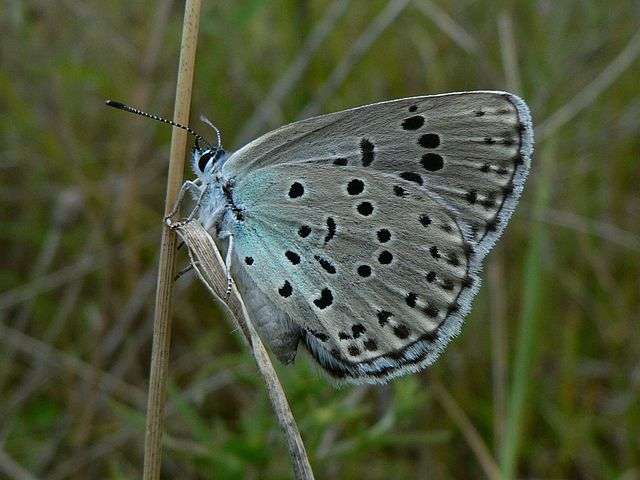Farms in UK Saved This Beautiful Duke of Burgundy Butterfly From Extinction
Once the rarest butterfly in England, a decade of work from the Butterfly Conservation has seen their numbers rebound 25%.

After a 150-year absence, 750 of the aptly-named large blue butterflies have successfully emerged from their cocoons to repopulate parts of their historic habitat in South West England.
Most conservation dollars don't reach beyond elephants, pandas, and tigers, but English biologists—notoriously proud and connected to the natural life on their island—needed only five years to begin repopulating part of the country with the largest of England's nine blue butterfly species: an unmistakable creature thanks to the row of black spots on its upper forewings.
Phengaris arion, which is called the ‘large blue', was officially declared extinct in Britain in 1979, but efforts from private trusts and ecological associations created the world's largest and most successful insect conservation program in the world, and from 1984 to 2008, it saw the large blue return to 30 previously occupied and new breeding sites.
The most recent project in Minchinhampton and Rodborough Commons in Gloucestershire is where conservationists recorded the rousing success, with 750 butterflies emerging after 1,100 larvae had been released in the area. None of these creatures had been seen in the local area for 150 years.
Furthermore, they have confirmed these butterflies to be laying eggs in the wild.
"Creating the right conditions for this globally endangered butterfly to not only survive but to hopefully thrive has been the culmination of many years work," said Richard Evans, area ranger for the Commons.
The large blue's recovery is a classic ‘web of life' example of how animals and plants rely on one another to survive. It's not enough to protect the butterflies, and scientists—like those working at the Butterfly Conservation Trust—have had to organize protection for wild thyme and red ants, two species that are integral parts of the large blue's world.
Wild thyme and marjoram are the large blue caterpillar's primary food source, and red ants work symbiotically to protect the caterpillars from danger.

David Simcox, research ecologist and co-author of the Commons management plan, noted this importance in a statement: "In the summer when the ants are out foraging, nature performs a very neat trick—the ants are deceived into thinking that the parasitic larva of the large blue is one of their own and carry it to their nest."
"It's at this point that the caterpillar turns from herbivore to carnivore, feeding on ant grubs throughout the autumn and spring until it is ready to pupate and emerge the following summer," he added.
In 2014, the Butterfly Conservation Trust finished a massive restoration of large blue habitat in the Polden Hills in Somerset, including the planting of over 100,000 wild thyme plants on seven different sites, as well as enhancing 10 hectares (30 acres) of scrub habitat for the red ants.
The project resulted in three re-colonizations, as well as one entirely new breeding site, and by 2019 there were 10 large blue breeding sites altogether, a jump up from six in 2017, according to an article in the magazine, Butterfly.
As a pollinator, the large blue's recovery paints an encouraging sign for biodiversity strength in England and for the world. Cheers to that.
FLUTTER The Happy Blue News Over To Your Friends on Social Media…
Be the first to comment